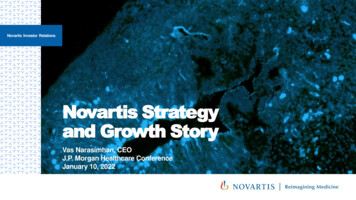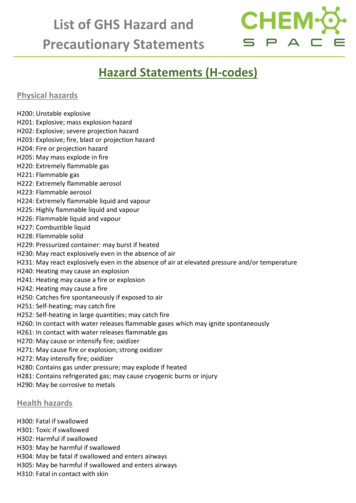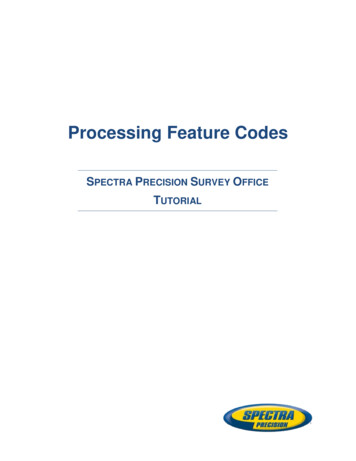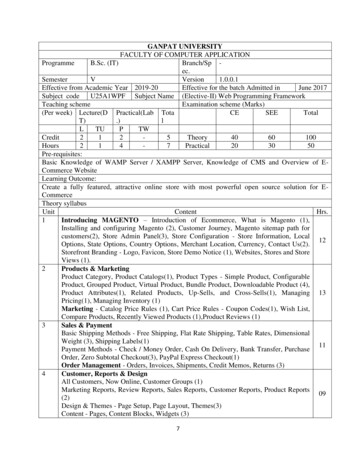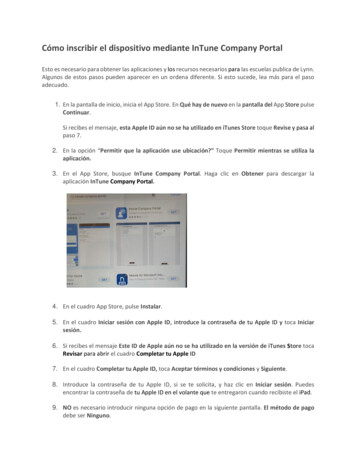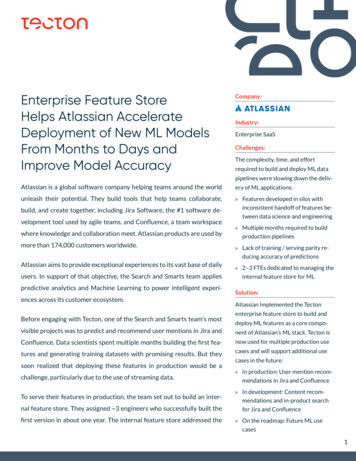
Transcription
Enterprise Feature StoreHelps Atlassian AccelerateDeployment of New ML ModelsFrom Months to Days andImprove Model AccuracyCompany:Industry:Enterprise SaaSChallenges:The complexity, time, and effortrequired to build and deploy ML datapipelines were slowing down the deliv-Atlassian is a global software company helping teams around the worldery of ML applications:unleash their potential. They build tools that help teams collaborate,» Features developed in silos withinconsistent handoff of features between data science and engineeringbuild, and create together, including Jira Software, the #1 software development tool used by agile teams, and Confluence, a team workspacewhere knowledge and collaboration meet. Atlassian products are used bymore than 174,000 customers worldwide.Atlassian aims to provide exceptional experiences to its vast base of dailyusers. In support of that objective, the Search and Smarts team appliespredictive analytics and Machine Learning to power intelligent experiences across its customer ecosystem.Before engaging with Tecton, one of the Search and Smarts team’s most» Multiple months required to buildproduction pipelines» Lack of training / serving parity reducing accuracy of predictions» 2–3 FTEs dedicated to managing theinternal feature store for MLSolution:Atlassian Implemented the Tectonenterprise feature store to build anddeploy ML features as a core compo-visible projects was to predict and recommend user mentions in Jira andnent of Atlassian’s ML stack. Tecton isConfluence. Data scientists spent multiple months building the first fea-now used for multiple production usetures and generating training datasets with promising results. But theycases and will support additional usesoon realized that deploying these features in production would be achallenge, particularly due to the use of streaming data.To serve their features in production, the team set out to build an internal feature store. They assigned 3 engineers who successfully built thefirst version in about one year. The internal feature store addressed thecases in the future:» In production: User mention recommendations in Jira and Confluence» In development: Content recommendations and in-product searchfor Jira and Confluence» On the roadmap: Future ML usecases1
most pressing issue of serving features online, but didn’t bridge the dataResults:science / engineering gap and would not scale to support all of Atlassian’sAtlassian has improved over 200,000 cus-needs. Teams were still operating in silos, it still took months of effort totomer interactions per day with Tecton:» Accelerated time to build and deploynew features from 1-3 months to 1 daybuild production pipelines, and the lack of training / serving parity wasreducing the accuracy of predictions.To address these gaps, Atlassian evaluated the Tecton feature store tomanage the complete lifecycle of features in Atlassian’s operational MLstack. After a successful Proof of Concept, Tecton was deployed in production to power predictive experiences, such as recommending contentfields in Jira and Confluence. By using Tecton as their data platform forML, Atlassian has accelerated the delivery of new features from a range of1-3 months to just 1 day, and has increased the prediction accuracy of existing models by 2%. These changes are directly improving over 200,000customer interactions every day in Jira and Confluence.» Introduced management of ‘featuresas code’ and brought DevOps-like practices to feature engineering» Started building a central hub of production-ready features which will enable feature re-use and collaboration» Improved the prediction accuracy ofexisting models by 2%» Improved the accuracy of onlinefeatures from 95%–97% accurate to99.9% accurate» Freed up 2–3 FTE from maintainingthe Atlassian feature store to focus onother prioritiesML Use Case PrioritiesThe Search and Smarts team builds and operates multiple ML applications to improve the customer experience in Atlassian products. For example, the team built an application to predict user mentions, assignees,and labels in Jira and Confluence. User mentions are used to draw someone’s attention to a page or comment, while assignees and labels are usedto allocate work and categorize content. Instead of simply providing adropdown list by alphabetical order, models predict and suggest the rightcontent up to 85% of the time. For power users that are assigning 100sof tickets a day, this can meaningfully reduce the time spent on repetitivetasks.Another high-priority use case is to improve the in-product search experience. Search is used extensively to quickly find relevant pages and totrack down issues. It’s an essential capability for large teams that mayhave thousands of pages and issues to search through.2
Recommended issue labelsfor every Jira issueRecommended work allocation and content categorization in JiraChallenges Getting ML to ProductionThe Search and Smarts team quickly realized that building and deploying these ML applications at scale would require a new platform for operational ML. Indeed, Atlassian operates at massive scale:» 174,000 customers» Billions of events generated every day» Hundreds of millions of feature-key combinations per model» 1M individual predictions generated every dayGetting the first models to production at this level of scale was a complex process. Without a feature store in placeto manage the lifecycle of ML features, teams were struggling with:Lack of collaboration tools spanning data science and engineering: The teams didn’t have a single repository of features that spanned both development and production environments. Keeping code in sync between data science and engineering required extensive manual coordination through meetings and writtendocuments.Complexity of incorporating streaming data: Many of Atlassian’s features are built with a combination ofbatch and streaming data to leverage the company’s valuable historical information while also capturing the3
latest events. The use of streaming data introduced unique challenges, such as carefully managing eventtime to prevent data leakage in training datasets and implementing streaming pipelines in production.Lead times of multiple months to deploy production pipelines: Features created by data scientists werenot production-ready. Much of the data scientists’ work needed to be reimplemented for production by aseparate data engineering team. This included creating and maintaining the infrastructure to process features with streaming data, hardening production pipelines, and adding monitoring to batch pipelines.Reduced prediction accuracy due to training / serving skew: The pipelines used to serve online and offlinedata were built with different code bases and different data sources. This introduced online / offline dataskew which in turn reduced the accuracy of predictions.To overcome these challenges, the team set out to build an internal feature store from scratch. Inspired by the UberMichelangelo platform, Atlassian’s original feature store was successfully delivered by a small team of 3 full-timeengineers in one year. The feature store was successful in serving features online, but it was not designed to solvethe tooling gap between data science and engineering. Data scientists were still building features in a separate environment from production, and pipelines still needed to be re-implemented in production.SolutionTecton was founded by the creators of Uber Michelangelo and provides an enterprise-ready feature store. Atlassian believed that Tecton could address many of its challenges in productionizing ML, while eliminating the need tomanage and maintain its own internal feature store.Atlassian and Tecton ran a Proof Of Concept project. Over the course of a few months, the teams worked togetherto implement the Tecton enterprise feature store and test the most important use case on Tecton: the models thatpredict user mentions, assignees, and labels in Jira and Confluence. After the successful POC, Atlassian is nowrunning multiple models in production on Tecton, and has decided to deploy the Tecton feature store as a corecomponent of Atlassian’s ML stack for future use cases.4
Results“ As a net result of using the Tecton feature store, we’ve improved over200,000 customer interactions every day. This is a monumentalimprovement for us.”Geoff Sims, Atlassian Data ScientistThe Tecton enterprise feature store is serving online features for several production models, has improved over200,000 customer interactions per day, and provides a strong foundation to scale ML at Atlassian. Powered byTecton, the Search and Smarts team:Introduced engineering best practices with centrally-managed feature definitions. Data scientists nowhave a consistent way of defining features as code stored in a Git version-control repository and surfaced toeveryone at the company. Data scientists can search and discover existing features, and collaborate moreeffectively on new feature development. The central feature definitions are used to generate both offlinetraining data and online serving data, providing consistency in the way features are managed across datascience and engineering.Accelerated the time to build and deploy new features from 1-3 months to 1 day. Data scientists can discover existing features to repurpose across models, and build and deploy new features to production in just1 day. They can create accurate training datasets with just a few lines of code, relying on Tecton to managetime travel and prevent data leakage. They can serve streaming features to production instantly withoutdepending on data engineering teams to reimplement pipelines. These sorts of timeframes empower datascientists to innovate at a much faster pace.Improved the prediction accuracy of existing models by 2%. Once migrated to Tecton, prediction accuracyincreased by 2% by delivering more accurate data and eliminating training/serving skew. The ease of use ofTecton enabled the teams to build new models that increased prediction accuracy up to 20%.Improved the accuracy of online features from 95%–97% accurate to 99.9% accurate. Tecton generatesboth training and serving data from a single pipeline compiled directly from data scientists’ feature definitions. By eliminating the need to reimplement pipelines in production, Tecton ensures training/servingparity and can surface more accurate insights.5
Reduced the engineering load by 2–3 FTE in the data infrastructure team. Atlassian no longer needs tobuild and manage its own feature store. This frees up precious engineering time in the data infrastructureteam to work on other high-priority projects.To achieve the company’s vision of building smarter, ML-powered user experiences, Atlassian needed an operational ML platform to productionize ML at scale. By using the Tecton enterprise feature store as the data layer of itsoperational ML stack, Atlassian now has the infrastructure in place to scale ML initiatives and support their longterm product vision. Tecton provides the confidence of a high performing, always-available system that empowersdata scientists to build new features and deploy them to production quickly and reliably.tecton.ai6
fields in Jira and Confluence. By using Tecton as their data platform for ML, Atlassian has accelerated the delivery of new features from a range of 1-3 months to just 1 day, and has increased the prediction accuracy of ex - isting models by 2%. These changes are directly improving over 200,000 customer interactions every day in Jira and .
